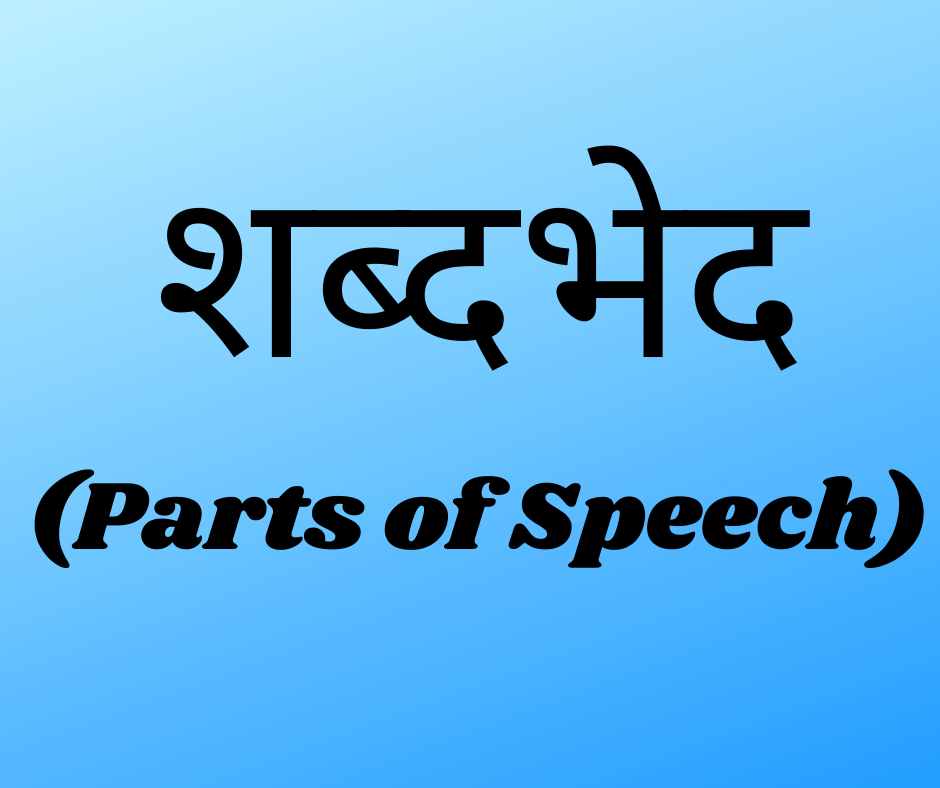अंग्रेजी में विभिन्न शब्दभेद क्या होते हैं ? (What are various Parts of Speech in English ?)

Overview
इस लेख में हम अंग्रेजी के एक महत्त्वपूर्ण अध्याय के बारे में जानेंगे - Parts of Speech in English, in Hindi
शब्दों को वाक्य में उनके प्रयोग और कार्य के अनुसार अलग-अलग वर्गों में विभाजित किया जाता है, जिन्हें Parts of Speech (शब्दभेद) कहा जाता है।
Parts of Speech आठ होते हैं:
- संज्ञा (Noun)
- विशेषण (Adjective)
- सर्वनाम (Pronoun)
- क्रिया (Verb)
- क्रिया विशेषण (Adverb)
- पूर्वसर्ग (Preposition)
- समुच्चयबोधक (Conjunction)
- विस्मयादिबोधक (Interjection)
कुछ आधुनिक व्याकरण की पुस्तकों में एक और वर्ग होता है - डिटर्मिनर्स (Determiners)
आर्टिकल, articles (a, an, the) भी निर्धारकों की श्रेणी में आते हैं।
क्रिया (Verb)
क्रिया (Verb) एक ऐसा शब्द है, जिसका उपयोग किसी क्रिया (action) या अवस्था (state) को व्यक्त करने के लिए किया जाता है।
The boy wrote a letter to his dad. (wrote – यह एक क्रिया है)
action verb
Bristol is a big city. (is – यह एक अवस्था है)
अंग्रेजी भाषा में क्रिया (Verbs) सबसे महत्वपूर्ण शब्द होते हैं। इसके दो मुख्य कारण:
a. अंग्रेजी के हर वाक्य में एक क्रिया (verb) होनी चाहिए।
b. क्रिया (verb) भाषण के एकमात्र भाग हैं, जो काल (tenses) को दर्शा सकते हैं।
tenses
संज्ञा (Noun)
संज्ञा (Noun) वह शब्द है, जो किसी व्यक्ति, स्थान या वस्तु के नाम के रूप में प्रयुक्त होता है। इसके अलावा, विचार, अमूर्त चीजें भी, जैसे की happiness, time, आदि।
संज्ञाओं (Nouns) को कभी-कभी 'naming words' कहा जाता है।
Ashoka was a king.
noun king
Aanya went to Andaman on vacation with her husband last year.
nouns
सर्वनाम (Pronoun)
सर्वनाम (Pronoun) संज्ञा के स्थान पर प्रयुक्त होने वाला शब्द हैं। यह एक संज्ञा (Noun) को प्रतिस्थापित करता है।
Mragank is absent, because Mragank is ill. (सुनने में अजीब लगता है)
Mragank is absent, because he is ill. (he - Subject pronoun)
The cards are where you left the cards. (सुनने में अजीब लगता है)
The cards are where you left them. (them - Object pronoun)
Subject pronouns – Subject का काम कर रही संज्ञा की जगह प्रयुक्त होते हैं| जैसे की, I, you, we, they, he, she, it
Object pronouns – Object का काम कर रही संज्ञा की जगह प्रयुक्त होते हैं| जैसे की, me, you, us, them, him, her, it
विशेषण (Adjective)
विशेषण (Adjective) वह शब्द है, जिसका प्रयोग संज्ञा (noun) या सर्वनाम (pronoun) के अर्थ में कुछ जोड़ने के लिए किया जाता है।
विशेषणों को कभी-कभी 'describing words' कहा जाता है।
Ashoka was a king.
Ashoka was a great king.
He is a boy.
He is a brave boy.
There are boys in this club.
There are forty boys in this club.
क्रिया विशेषण (Adverb)
क्रिया विशेषण (Adverb) एक ऐसा शब्द है जिसका उपयोग क्रिया (verb), विशेषण (adjective) या किसी अन्य क्रिया विशेषण (adverb) के अर्थ में कुछ जोड़ने के लिए किया जाता है। वे कहां, कब, कैसे, क्यों (Where, When, How, Why) सवालों के जवाब देते हैं।
The boy wrote a letter to her dad.
The boy quickly wrote a letter to her dad. (wrote – verb; How? - quickly, wrote verb को संशोधित करने वाला adverb)
He is a brave boy.
He is a very brave boy. (brave - adjective; very - brave adjective को संशोधित करने वाला adverb)
She pronounced the word.
She pronounced the word correctly. (pronounced – verb; correctly - pronounced verb को संशोधित करने वाला adverb)
She pronounced the word quite correctly. (quite - correctly adverb को संशोधित करने वाला adverb)
- वे एक पूरे वाक्य में भी अर्थ जोड़ सकते हैं।
We went on a walk.
Yesterday evening, we went on a walk. (went – verb; When? - Yesterday evening)
adverb
They missed the bus and were late to their own party!
Unfortunately, they missed the bus and were late to their own party! (Unfortunately - adverb)
तो विशेषण (adjectives) और क्रिया विशेषण (adverbs) दोनों ही अर्थ में कुछ जोड़ते हैं, अर्थात वे कुछ अतिरिक्त जानकारी देते हैं।
पूर्वसर्ग (Preposition)
एक पूर्वसर्ग (Preposition), एक संज्ञा (noun) या सर्वनाम (pronoun) के साथ प्रयोग किया जाने वाला शब्द है, जो यह दर्शाता है कि संज्ञा या सर्वनाम द्वारा निरूपित व्यक्ति या वस्तु का किसी और चीज से क्या संबंध है।
- पूर्वसर्ग (Prepositions) संज्ञा / सर्वनाम (noun/pronoun) में समय, स्थान और गति का विचार जोड़ सकते हैं।
There is a butterfly in the garden. (in – Place - Where?)
preposition
I'll see you at the office on Tuesday. (at – Place - Where? ; on – Time - When?)
The driver moved towards the door. (towards - Movement)
- पूर्वसर्ग (Prepositions) दूसरे शब्दों को संज्ञा/सर्वनाम (noun/pronoun) से जोड़ सकते हैं
It depends on the cost. (यहाँ preposition ‘on’, noun ‘the cost’ को verb ‘depends’ से जोड़ता है)
समुच्चयबोधक (Conjunction)
समुच्चयबोधक (Conjunction) वह शब्द है, जिसका उपयोग शब्दों (words), वाक्यांशों (phrases), उपवाक्यों (clauses), या वाक्यों (sentences) को जोड़ने के लिए किया जाता है।
समुच्चयबोधक शब्दों (Conjunctions) को कभी-कभी 'joining words' कहा जाता है।
Mragank and Anand are cousins.
I ran fast. I missed the bus.
I ran fast, but missed the bus.
conjunction
विस्मयादिबोधक (Interjection)
विस्मयादिबोधक (Interjection) एक ऐसा शब्द है, जो कुछ अचानक होने वाली भावना व्यक्त करता है।
उनका कोई वास्तविक अर्थ नहीं होता है।
Alas! She is dead.
Wow! What a sight.
interjection
विस्मयादिबोधक शब्दों (Interjections) का प्रयोग आमतौर पर बोल-चाल में अधिक और लिखित रूप में कम किया जाता है।
लिखित रूप में इस्तेमाल किये जाने पर, उनके बाद अक्सर विस्मयादिबोधक बिंदु (exclamation point) प्रयुक्त होते हैं।
शब्दभेद की बहुपरतीय प्रकृति (Multi-layer Parts of Speech)
न केवल शब्द (words), बल्कि वाक्यांश (phrases) और उपवाक्य (clauses) भी संज्ञा, क्रिया, क्रिया विशेषण, विशेषण आदि के रूप में भी काम कर सकते हैं।
यह parts of speech को बहुस्तरीय बनाता है।
वाक्य का कौन सा भाग, भाषा के किस भाग के रूप में काम करता है, यह इस बात पर निर्भर करेगा कि हम शब्द स्तर पर वाक्य का विश्लेषण करते हैं या वाक्यांश या उपवाक्य स्तर पर।
Add a small spoonful of common salt, then turn up the heat and move away from it.
(add - verb; a - determiner; small - adjective; spoonful - noun; of - preposition; common - adjective; salt - noun)
(add - verb; a small spoonful - determiner; of - preposition; common salt - noun)
(add - verb; a small spoonful of common salt - noun phrase)
अगर हम वाक्य के दूसरे भाग की बात करें तो:
(then - conjunction; turn up the heat - verb phrase; and - conjunction; move away from it - verb phrase)
इसे देखने का कोई एक सही तरीका नहीं है। ये सभी दृष्टिकोण सही हैं। आपको वह चुनना चाहिए, जो समझने में आसान लगे।
सन्दर्भ आधारित शब्दभेद (Context-based Parts of Speech)
शब्द जिस प्रकार से किसी वाक्य में काम करते हैं, उसी की अनुसार उन्हें विभिन्न Parts of Speech में वर्गित किया जाता है|
- कुछ शब्द हमेशा एक ही काम करते हैं।
जैसे की, Believe और destroy केवल क्रिया (verbs) की तरह काम कर सकते हैं। Independence केवल संज्ञा (noun) की तरह काम कर सकता है।
- लेकिन कुछ शब्द, वाक्य में उनके प्रयोग के आधार पर अलग-अलग काम करते हैं।
हम तब तक यह नहीं कह सकते हैं कि ऐसा शब्द किस part of speech से संबंधित है, जब तक कि हम इसे एक वाक्य में प्रयोग होते नहीं देख लेते।
Mragank has been chosen for the school play. (Noun)
Federer and Nadal play tennis together on Saturdays. (Verb)
play verb & noun
We ate in the afternoon. (Noun)
We had afternoon tea. (Adjective)
They arrived soon after. (Adverb)
They arrived after us. (Preposition)
They arrived after we had left. (Conjunction)
Are you well? (Adjective)
She speaks well. (Adverb)
Well! That's expensive! (Interjection)
I am staying in this evening. (in - adverb)
Look in the big box. (in – preposition)
तो, Parts of Speech संदर्भ आधारित होते हैं। आपको वाक्य को देखना होगा, और पता लगाना होगा कि उस वाक्य में कोई शब्द क्या काम कर रहा है।

अतिरिक्त पुस्तकें और उपकरण
यदि आप किताबों के माध्यम से सीखना पसंद करते हैं, या संदर्भ उद्देश्यों के लिए कुछ अच्छी अंग्रेज़ी व्याकरण किताबें चाहते हैं, तो आप हमारा यह लेख पढ़ सकते हैं|